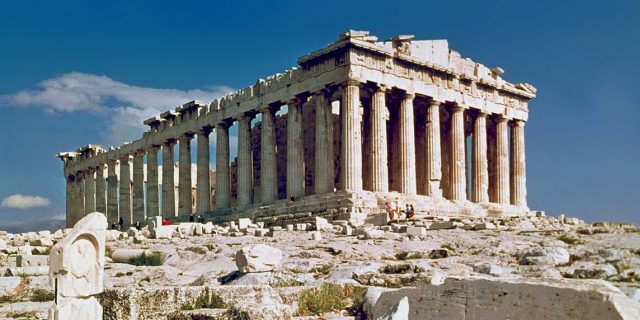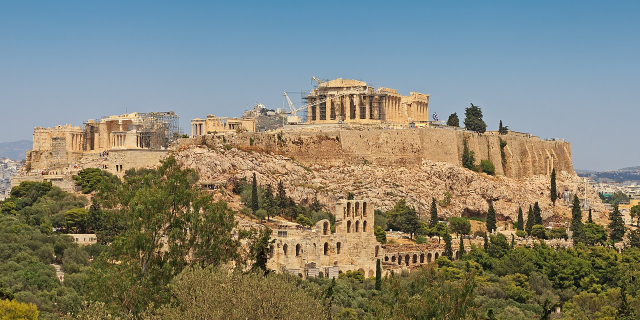Pláka (Greek: Πλάκα) is the old historical neighborhood of Athens, clustered around the northern and eastern slopes of the Acropolis, and incorporating labyrinthine streets and neoclassical architecture. Plaka is built on top of the residential areas of the ancient town of Athens. It is known as the "Neighborhood of the Gods" due to its proximity to the Acropolis and its many archaeological sites.
Plaka was developed mostly around the ruins of Ancient Agora of Athens.[1] It is the oldest district of Athens and has been continuously inhabited from the neolithic to the present day.[2] As a result, Plaka contains monuments form all periods of the city's history. Some of the streets, such as Adrianou and Tripodon, can be traced back to the ancient era.[2] The population of Athens grew during the early 16th century, and the town experienced another urban development after the one which occurred in 1456, this time towards the north-east, again mainly by the settlement of Albanians who had moved in the region several years before the Ottoman arrival. After the Ottoman conquest, these settlements occurred in Attica in one wave after the Venetian loss of its Morean strongholds in 1540, and in another wave after a revolt in the Morea in 1570, when the Ottoman administration decreed the mandatory settlement of Albanians in Attica, in order to offer them improving living conditions. The such created north-eastern district of Athens later became known as Plaka.[3] During that period, Plaka was also the home of the Greek aristocratic Benizelos family, the family that Saint Philothei came from.[4][5] In the mid-17th century, out of the eight main administrative units (platomata) in Athens, it appears Plaka was the least densely inhabited.[6]
During the Greek War of Independence, Plaka like the rest of Athens, was temporarily abandoned by its inhabitants because of the severe battles that took place in 1826. The area was repopulated during the first years of the reign of Otto of Greece. Plaka had a sizable Albanian community till the late 19th century, and as a result it was the Albanian quarter of Athens.[7][8][9][10][11] They had their own courts where they used the Albanian language. Their descendants nowadays have been assimiliated into the Greek nation in considerable numbers. This happened through Greek control over the education system.[7] At the same period the neighborhood of Anafiotika, featuring traditional Cycladic architecture, was built by settlers from the Aegean island of Anafi.[12]
Plaka assumed its present form in the late 19th and early 20th centuries. Following Greek independence, the area grew rapidly. Plaka became inhabited by a mixed population, that included old Athenian families as well as an influx of newcomers, such as artisans, professionals, military personnel, and others. In 1884 a fire burned down a large part of the neighborhood which gave the opportunity for the archaeologists to conduct excavations in the Roman Market and Hadrian’s library. Excavations have been taking place continuously since the 19th century. Growth continued until World War 2. From the 1950s until the 1970s, Plaka experienced some degradation, as a result of the post-war construction boom, the increase in motor cars, and the tourist boom.[2] In the 1980s, a comprehensive preservation plan was implemented, and the area improved rapidly. Nowadays Plaka is a major tourist destination.































Add new comment